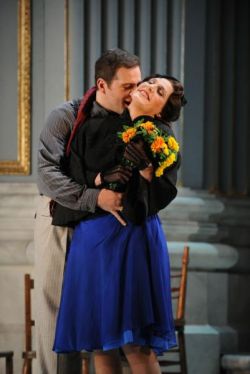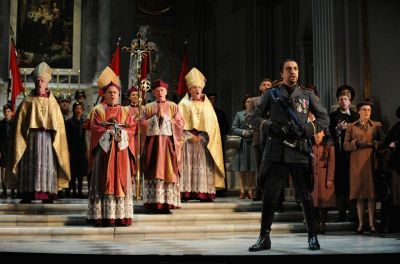Tosca
The three imposing sets of this production of Puccini’s Tosca have returned to the Sydney Opera House for a third summer season. And with a stunning and very popular cast, it promises to be just as successful.
Directed by the legendary John Bell, the opera has been transported from its original setting in Italy in 1800, where Napoleon’s troops approach to free Rome from tyrannical rule of the Kingdom of Naples, to the Nazi occupation of Rome in1943-44. The sets (Michael Scott-Mitchell) and costumes (Terese Negroponte) make the translation frighteningly credible – and are still breath-taking in their detail and towering height.
In Act 1, the imposing marble columns of the Sant’Andrea dell Valle church arch above the stage in stunning authenticity. In Act 2, set inside the German headquarters, long red banners adorned with swastikas drape the grey walls. Act 3 opens in the courtyard of the German headquarters, where high walls are strung with barbed wire.
The plot lends itself to this setting.
 Angelotti (David Parkin), who has just escaped from prison comes to hide in the Attavanti chapel of the Sant’Andrea dell Valle church and sings heart-renderingly of his fear of being re-captured. Thus he sets the scene for a plot that is full of fear and cruelty.
Angelotti (David Parkin), who has just escaped from prison comes to hide in the Attavanti chapel of the Sant’Andrea dell Valle church and sings heart-renderingly of his fear of being re-captured. Thus he sets the scene for a plot that is full of fear and cruelty.
The artist Mario Cavaradossi (Riccardo Massi), working in the church, agrees to help him escape but tells him to hide when his lover Tosca approaches.
Tosca (Amanda Echalaz) suspects Cavaradossi of having an affair with the Marches Attavanti, but Cavaradossi assures her of his love. Convinced, Tosca leaves and Cavaradossi rushes Angelotti to safety.
Baron Scarpia (Claudio Sgura), hot on Angelotti’s trail learns of Cavaradossi’s involvement. He also finds a fan with the Attavanti crest and which he uses to inflame Tosca’s jealousy in a ploy to win her for himself. (Iago had the handkerchief, I have the fan).
Cavaradossi is arrested and led away to be tortured just as Tosca arrives from a singing engagement. The moans of Cavaradossi off stage are too much and she reveals Angelotti’s hiding place. She begs for the life of her lover, and finally agrees to Scarpia’s ‘price’, but only after he pretends to agree to a mock execution for Cavaradossi and a letter of safe passage for them. As he begins to molest her, she stabs him and escapes with the letter.
Unfortunately the execution is real and Tosca is left with her lover’s body and an assassination charge.
Ricardo Massi’s first aria Recondita armonia (How strange a thing is beauty) is a powerful introduction to an opera that is filled with music that emphasises the drama of the plot and sends it to soaring heights.
Amada Echalaz revels in the duets and arias that Puccini crafted for the heroine of his opera. Her powerful voice is filled with sustained fear and tension as she pleads and bargains with Scarpia, and the cut and thrust of their duets is beautifully executed.

Claudio Sgura’s Scarpia is a villain easy to hate, but even as he struts and sneers chauvinistically about how he prefers to conquer a woman violently than for her to surrender meekly, his voice woos the audience with its great strength and power.
This is an opera for powerful and dramatic voices and Echalaz, Massi, Sgura and Parkin do not disappoint.
Neither do those in other roles. Graeme Macfarlane is the bumbling Sacristan, with a constantly dripping nose. Benjamin Rasheed is the henchman Spoletta, Tom Hamilton the Gaoler and Adrian Tamburini is Sciarrone.
The orchestra, conducted with great dramatic verve by Italian conductor Andrea Battistoni, seems to revel in Puccini’s “deep and intuitive grasp of human psychology and the skill to translate it into music … the music is never there as decoration”. (John Bell).
Carol Wimmer
Images: Claudio Sgura as Scarpia and Luke Gabbedy as the Sacristan; Riccardo Massi as Cavaradossi and Amanda Echalaz as Tosca, & Claudio Sgura as Scarpia and the Opera Australia Chorus. Photographer: Branco Gaica.
Subscribe to our E-Newsletter, buy our latest print edition or find a Performing Arts book at Book Nook.

